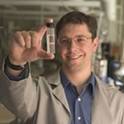The conversion of biomass into biofuel products by pyrolysis has attracted tremendous interests due to high availability and potential to provide sustainable liquid fuels. Cellulose is the most abundant polymeric carbohydrate compound, which comprise the largest fraction of biomass. During the pyrolysis, cellulose undergoes multiple decomposition pathways depending on the thermal conditions and produces different classes of compounds including non-condensible gases, condensable vapors that are condensed into a liquid mixture, solid chars. In spite of numerous efforts to understand reaction mechanism for cellulose pyrolysis, a reliable reaction model describing both heat release and intrinsic themokinetic behavior is not developed yet due to the lack of means to quantify the heat involvement of individual steps. In the present study, cellulose pyrolysis experiments at isothermal and dynamic conditions are carried out to characterize the evolution of products depending on thermal conditions. Observed decomposition behaviors are compared with an intrinsic kinetic model to estimate the reaction rates and heats of reactions for individual reaction steps.
Available at: http://works.bepress.com/george_huber/5/
